AMEC Camino 701 Class A AIS, first with a nearly complete NMEA 2000 interface
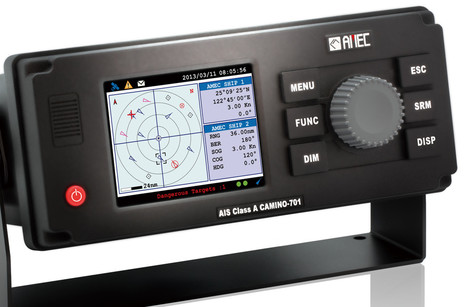 There are several reasons that a yacht or workboat might want to use an AIS Class A transceiver instead of Class B, even if they’re not required to. With Class A you’ll be seen by other boats from a greater distance because you’ll be transmitting at 12W instead of 2, and you’ll be tracked much more smoothly — particularly if you’re going fast and/or manuevering — because the Class A update rate for dynamic data like position, speed, and heading is much more frequent than Class B. The problem is that the total install cost of Class A can be quite high and especially annoying on a modern boat with a NMEA 2000 network — despite what you may have read on Panbo! — because no Class A truly supported N2K until the AMEC Camino 701 came along (and it’s not perfect yet)…
There are several reasons that a yacht or workboat might want to use an AIS Class A transceiver instead of Class B, even if they’re not required to. With Class A you’ll be seen by other boats from a greater distance because you’ll be transmitting at 12W instead of 2, and you’ll be tracked much more smoothly — particularly if you’re going fast and/or manuevering — because the Class A update rate for dynamic data like position, speed, and heading is much more frequent than Class B. The problem is that the total install cost of Class A can be quite high and especially annoying on a modern boat with a NMEA 2000 network — despite what you may have read on Panbo! — because no Class A truly supported N2K until the AMEC Camino 701 came along (and it’s not perfect yet)…
Indeed, I enthused about a new ComNav Class A with NMEA 2000 back in 2009, but apparently the N2K support never happened, which I didn’t realize until last fall when Panbo commenter Howard T. brought up the issue on that old ComNav entry. It turned out that none of these SRT-built Class A transponders — whether sold as the Em-Trak AIS A100, the Comar CSA 300, the Digital Yacht CLAS1000, or the True Heading Carbon Pro — ever got their N2K port activated, though all have stopped advertising the feature (while ComNav surprisingly still distributes the same erroneous Voyager X3 brochure).
While it’s true that most commercial vessels don’t give a hoot about NMEA 2000 because they don’t use it, AIS Class A (or B) is also a great example of how much N2K can simplify and improve an installation. Howard ended up getting a great deal on a used (though bulky) Furuno FA-150 Class A, but the install documented here involved many more components as well as “a lot of reading, a bunch of questions on the Furuno support forum, a few local experts and a lot of cables and itty bitty terminations.” And the complexities seem somewhat similar with this Comar Class A installation on the Nordhavn 60 Tanglewood. Both skippers seem pleased to have Class A now, but I suspect that they’d have simpler, more compact and less expensive installs if they’d tried the AMEC 701.
There seem to be four important aspects to getting the N2K interface completely right on an AIS transponder. To guarantee network compatability, the device should be NMEA 2000 certified, which AMEC (Alltek Marine Electronics Corp) earned for the 701 and its Camino-108 Class B in late 2013. But neither N2K certification nor the AIS type approvals guarantee that all the possible AIS PGNs will be output, as we once saw in some Class B devices that failed to output other Class B static data (now fixed) and more recently with AIS AtoNs (at least Garmin needs to update their AIS devices). The PGN list above from AMEC’s well written and illustrated 701 manual looks complete.
Then there’s the fact that an AIS transponder can output complete GPS data over NMEA 2000, even though there’s not enough bandwidth to do so over the conventional NMEA 0183 High Speed AIS output (which is also called IEC 61162-2). Again, this feature is not mandated by any standard, but it’s nice for a boater to get at least a backup GPS along with their new N2K AIS transponder. Vesper Marine has trailblazed this capability (as well as transponder as gateway/multiplexer) and AMEC added it to the 801 Class B last fall and to the 701 in February.
Finally, any AIS transceiver with a NMEA 2000 port should be able to receive Heading data over it, and every Class B I’ve ever tested has. It’s great, as the same N2K cable that outputs AIS target info (and sometimes GPS) to every display can also input the optional Heading info, which means your boat will plot correctly on other screens even when stopped. AMEC has been a little backwards about this capability, though; they just added PGN 127250 (Vessel Heading) input to the 801 in that same fall firmware update and still don’t support it on the 701. Actually, a Class A can also use PGN 127251 (Rate of Turn), but I think that input would also be easy to add and I’m hopeful that AMEC will do so. (Class A installations on IMO mandated vessels may be required to get Heading and RoT via NMEA 0183, but I understand that voluntary Class A installations will work without either value and aren’t required to have them.)
At any rate, aside from the NMEA 2000 Heading issue, the AMEC Camino-701 seems like a nice Class A AIS overall and especially so for boats using N2K. It’s just a little odd that you’ll see a (non-functional) N2K port on the back of all the SRT made Class A transceivers but not on the back of the 701.
That’s because AMEC put their N2K port on the junction box that also handles all the required Class A inputs, which may not be needed at all given how much the NMEA 2000 interface could do!
The AMEC 701 junction box does look well designed and there may be use for some of the many possible non-NMEA-2000 connections on some yachts or workboats — like the Long Range (LR) connection I’ll discuss below — but most modern yachts would just use the N2K port, which even includes a built-in switchable backbone terminator.
I haven’t tried installing a Camino-701 but I did download the impressive PC configuration software and think it may often be used for more than initial setup or diagnostics. It’s nice that Class A AIS broadcasts Voyage Data that can help other vessels better understand what you’re up to, but it also includes an obligation to keep that data current. While you can enter this information and do most other configuration tasks on the 701 display, it’s a lot easier to type CAMDEN MAINE on a keyboard than scrolling through the letters with a knob. I think that the Voyage Data above reasonably describes Gizmo on her dock in New Bern, NC, though I could certainly get more specific about Destinations and ETAs once I get going. (I do know I won’t be home until mid-June because I’m planning to teach at the new early June TrawlerFest event in Essex, CT.)
Another feature I noticed in the Configuration software is the ability to set the voltage for the active GPS antenna; the 701 comes with a GPS antenna but the install could be even easier if you can use an existing one. Also, illustrated above is the LR feature I already mentioned and which I’m just learning about. Apparently, you can connect the 701 to a satellite communications system and send off an automated Long Range AIS Broadcast Message, though I don’t know what types of comms systems can handle this and who gets to see your long range tracking. Anyone?
More relevant to many yachts is a table that lets you assign useful names to specific MMSI numbers associated with AIS MoB devices (which don’t support normal static data like boat names). I joked around a bit in my test table, but that inset McMurdo Smartfind M5 Class A AIS — which looks like a rebranded AMEC Camino-701 — illustrates how the feature works with the proper AIS MoB/SART symbol on screen. I don’t know if any other Class A or B devices have this feature, but will note that the Simrad V5035 Class-A AIS also seems to be a rebranded 701.
Though untested by me, I’d say that AMEC has produced a fine Class A AIS, and it may also be the least expensive, at least at Milltech Marine’s $1,999 sale price. Let’s hope that some of the commercial boats recently required by the USCG to carry at least a Class B decide to upgrade to A, and some yachties may be interested, too (though sailors may shy away from the 9W average, 65W peak power usage). Below is a table showing the fairly dramatic dynamic data update differences between A and B. It’s interesting how much we fretted about Class B slowness before we got used to it, but isn’t A still better?


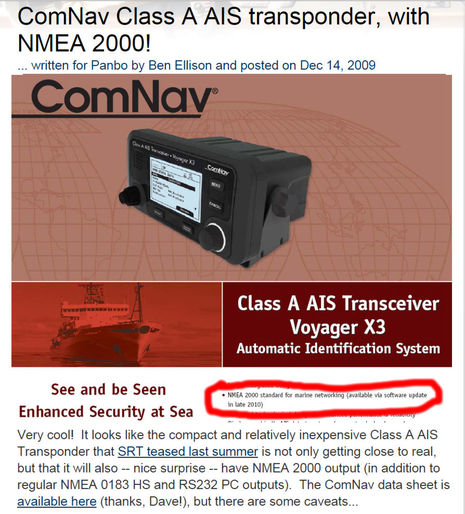
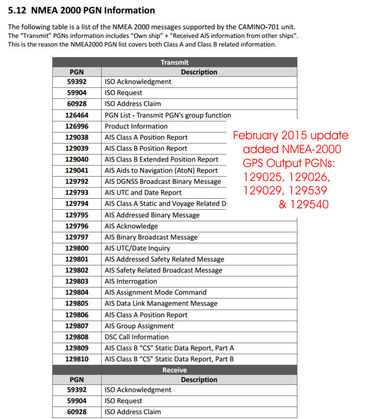
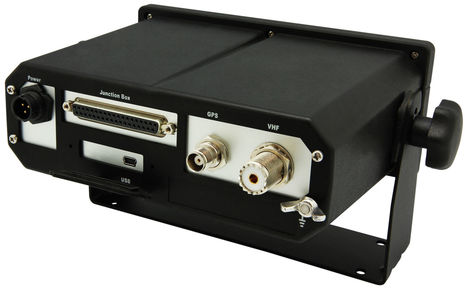
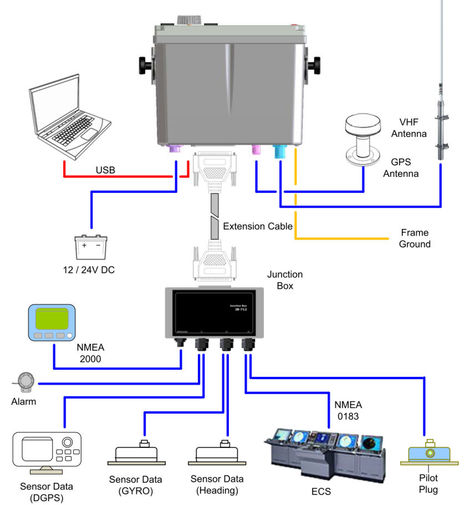
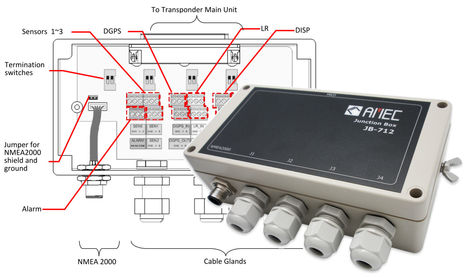
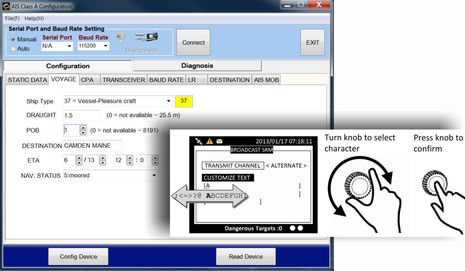
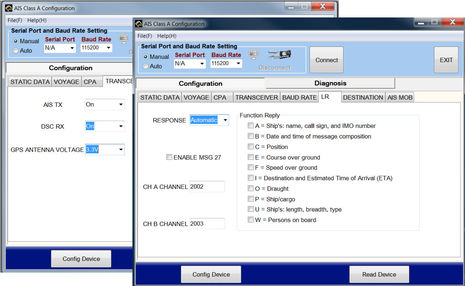
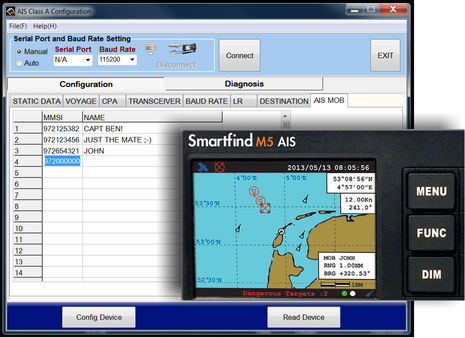
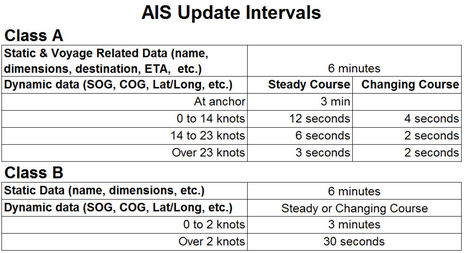



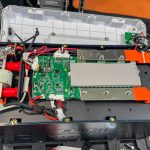








I’m the Nordhavn 60, Tanglewood, who installed the ComNav Class A AIS referenced above. The AMEC 701 is a really interesting product, and I seriously considered using it in my boat. Much of the attraction was the N2K interface which I thought would eliminate the need for the two N2K to 0183 converters required to install the ComNav X3. But along the way I learned a bunch of things that I didn’t know going in.
Unlike Class B AIS where the integrated GPS provides the data that’s transmitted to other ships, Class A devices MUST be provided with external heading, rate of turn, and GPS data. The integrated GPS which is also part of Class A devices is strictly used as a backup in the event of a loss of the external data. If the external data sources are lost, the Class A AIS alarms, but keeps running using the data from the integrated GPS.
The catch with the N2K interface on the AMEC 701 is that it’s output only, and can’t be used to feed external heading, rate of turn, and GPS data to the device. This data can only come in on the various 0183 ports. I haven’t researched this personally, but my understanding is that IMO only recognizes 0183, and since to be of any interest a Class A AIS needs to be IMO certified, that’s not likely to change anytime soon.
So the value in the N2K interface is restricted to getting AIS position reports onto your N2K bus – something that would otherwise require an 0183 adapter running at 38.4kb, and supporting all the AIS sentences and PGNs. It does help, and in my case would have eliminated one converter, but I still needed a second converter for all the heading and GPS info, and that would be required for the AMEX 701 as well assuming your heading and GPS sources live on N2K somewhere as they do on my boat.
Thanks for posting, Peter, but isn’t it possible that you were misinformed about Class A AIS installations on vessels that are not under IMO regulations? I’m not 100% certain but I believe that external GPS, Heading, and RoT are all optional on non-SOLAS vessels, and at least the latter two values could be input via NMEA 2000.
I have been told by Milltech Marine that they’ve seen Class A installations that worked fine without external inputs, but I do want to be certain that that’s legitimate on at least voluntary Class A vessels.
I will do more research, and it’s quite possible that other Panbo readers will have solid information on this subject. If I misstated the install requirements in the entry, I will definitely fix it!
Peter, I just spoke with SRT, the company that built your Comar Class A and many others, and they confirmed that IMO AIS installation standards do NOT apply to vessels not regulated by the IMO. In other words, they are separate from the type approval standard.
In fact, SRT says that many non-IMO vessels install Class A transceivers just like Class B, with no external sensors. It is of course preferable to collect and broadcast Heading, RoT, and maybe even external GPS input, but it is not required. Those inputs could also be done over NMEA 2000 (IEC 61162-3) on non-IMO vessels (if the N2K port supports the PGNs).
I think that the same situation applies to the U.S. commercial vessels recently required to carry Class A by the USCG, but I’m trying to confirm.
PS The IMO Installation Guidelines can be downloaded from this Web page, which also states the vessels they apply to:
http://www.imo.org/OurWork/Safety/Navigation/Pages/AIS.aspx
I’m not sure what the IMO requirements say, nor how other Class A devices behave, but I can say for certain how the SRT family of products (ComNav X3, Comar CSA300, Digital Yacht CLS 1000, Raymarine CLass A, etc.) operate.
Yes, the AIS device continues to operate if there is no external heading or GPS. But it also will be in a perpetual state of alarm. I recall 4 in total; No Heading, No SOG, No COG, no ROT. But there may be more. The alarms can be acknowledged which silences the unit and deactivates the external alarm trigger, but the alarms persist and remain active on the screen.
One could certainly just ignore these alarms, but I would be uncomfortable with a boat where any continuous alarm is part of normal operation.
On first inspection, bringing heading and GPS into the AIS seems straight forward, but can quickly become much more complicated when you primary devices are on N2K.
First, the ComNav AIS and it’s cousins, along with the Furuno FA150, all insist on True heading in the form of HDT. That means two things; 1) the N2K to 0183 adapter needs to generate HDT, and 2) there needs to be a source of True heading on the N2K bus. In my delve into this quagmire, I found that not all converts produce HDT. I also found that none of them will take the magnetic heading from a Rate Compass and combine it with Magnetic Variation from a GPS to create HDT. So your N2K heading source has to produce a True heading, and that basically means it has to be a Sat Compass. I haven’t found any rate compass that will produce a true heading on N2K.
Second, if you have multiple heading and GPS sources on N2K, it’s desirable to ensure that the best source of data, if available, gets fed to the AIS device. How the various N2K to 0183 converter perform source selection of N2K data is often unclear, and in all cases but one, cannot be controlled by the operator or system installer. You basically get whichever source the converter decides on based on whatever algorithm is uses. This might correspond exactly with what you want, but then again it might not. I even encountered one converter that did no source selection at all, and simply converted PGNs from any and all N2K sources. This created significantly more traffic on the 0183 side than there should have been, and created position reports that jumped back and forth based on the different locations of my GPSs. That little puppy was really broken, in my view.
In the computer world this is referred to as deterministic vs non-deterministic behavior. I ended up having to install a physically switched source selector to achieve deterministic behavior.
Our posts crossed in space….
No disagreement on whether the Class A devices continue to operate without the external data inputs.
And no disagreement on whether the IMO requirements apply to us smaller boats, and hence whether we are required to have those connections. We aren’t.
But in practice, your AIS will be in a constant state of alarm if you omit the input data.
All that said, I too would welcome a Class A device with the option to handle everything over N2K. It sure would have made my life a lot easier.
Above comments match what I have experience with the Furuno FA150. It will function, but will be in a constant alarm status.
The Furuno will not accept heading over 0183. It requires Furuno AD-10 format.
Thanks, Peter; glad you agree now that external sensors are not required for a Class A AIS.
I don’t like the idea of regular alarms either but there must be a lot of AIS transceivers showing them. The AMEC 701 seems to be similar to SRT and Furuno in alarming on absence of RoT, but RoT isn’t even required on IMO level vessels.
Also, I think a lot of your issues with NMEA 2000 would go away if you could use it directly instead of via converter. For instance, I can not remember an N2K network I’ve used that did not have True Heading on it, and I’ve only used a satellite compass once, and briefly.
So I’m hoping AMEC will update the 701 to receive Heading and RoT over N2K. (I wouldn’t expect N2K source selection, though. It’s nice, but not necessary and a lot to ask in a device like this.)
Re the FA-150, I don’t have direct experience with it, but think it might have been revised to now accept 0183 HDT as an alternative to AT-10 fro heading. At least that’s my read of their current manuals, but ti wouldn’t be the first time that what I think I’m reading doesn’t line up with reality.
Re converters, I would love to not need them. But as soon as you start adding IMO and other equipment certified for use on various grades of commercial vessels, it’s all 0183.
True heading is an interesting one. All my N2K systems have always been able to operate in True or Magnetic mode, and have done so with only a rate compass. But I have come to find this is because the various devices displaying my heading (chart plotter, auto pilot, or generic data display) are accomplishing this by combining data from two PGNs; 127250 Vessel Heading, and 127258 Magnetic Variation. Vessel heading comes from the rate compass, but in my experience does not include magnetic variation since the rate compass doesn’t know what it is. Magnetic variation typically comes from the GPS (good ones, not lower grade devices) and from chart plotters. The only device I have seen that puts out Vessel Heading in True format is a sat compass. All the rate compasses I have seen send out heading in magnetic format.
In theory a converter could process both PGNs and produce HDT, but from what I’ve seen, none do. The converters I’m aware of and have tried first hand are Actisense NGW, Furuno IF-NMEA2K2, Simrad AT10 and AT10HD, and the AMEC NK-80. None will produce HDT unless the Vessel Heading PGN contains a true heading.
So this is all a long way of saying that to have True Heading “on the network” I think requires a sat compass. To have True Heading derivable from what’s on the network is much simpler and almost always possible, but unfortunately doesn’t provide a way to get HDT into an IMO device like a Class A AIS or IMO radar.
Now don’t get me wrong. I’m actually a big fan and a big proponent of N2K. I’ve just tripped over a lot of warts in actual use in bigger systems, and hope that making people aware of them will help get them fixed so we can enjoy N2K’s full potential. I set out to build a boat that was 100% N2K, and ended up with one containing 4 major devices that are 0183 only, and a grand total of 5 converters to get it all to work properly.
“So this is all a long way of saying that to have True Heading ‘on the network’ I think requires a sat compass.”
Geez, Peter, not true! When I said True Heading has always been on my N2K networks, I really mean on my N2K networks, not just one device. I can see the True Heading value in the network stream and on any device capable of showing it. You are correct that True Heading is often calculated from values that are coming from more than one sensor, but devices that do such calculations also output PGNs. I really don’t want to get sidetracked on N2K issues here, so let’s please adjourn to your NMEA 2000 rant:
http://www.mvtanglewood.com/2015/02/nmea-2000-standard-committee.html
I’ve discussed the question of opening the N2K port for input of heading with two pretty technical staff at the AMEC booth at METS last November. I was told, they would seriously consider a request for this development if it were placed with them (I would think this entry here qualifies for a request) so we will see.
I was told, however, that the development discussed would only cover heading input, not any other data such as GPS information or ROT. Given what I have now read in this entry, that would not make too much sense because of the continuous alarm state.
I was attracted to a class A because of the added range it would give me. I would be seen as far away as I can see big ships and in the open water I have seen as much as 95 nm.
There were situations where I would have gladly accepted serious installation effort and 9W average power draw for the added range.
But Anders Bergström of True Heading (the company, not the data value discussed above) said he doesn’t think class A would make a significant difference in the rage at which my signal would be detectable. He would rather invest in top quality cable (which I think I have but my install was not measured). On the other hand, an AIS expert at the German HO office (BSH) told me a while ago that in his opinion class B is short on transmit power and therefore needs the highest-mounted antenna possible.
My long range needs aren’t so great at the moment but when I go ocean voyaging again, I will give this another serious thought.
Hopefully the 701 will have comprehensive N2K input capability by then or someone else will cover this market.
BTW, to be permitted into the Kiel Canal with a vessel 20 meters/65ft or over, the vessel must be equipped with class A or else rent a unit from the canal authorities for the passage.
Thanks, Henning! It’s funny that when I asked the same Heading over N2K question this week (via Milltech Marine), AMEC replied that it was the first time they’d heard the request. But I think that Doug Miller is going to pursue the feature and hopefully it will happen. I pointed out that most of the new big fast motor yachts shown at the Miami Boat Show have NMEA 2000 networks and could probably benefit from Class A AIS.
I believe that the sensor alarms on these Class A devices are fairly passive, just ringing on start up. I don’t like having any unnecessary alarms but I certainly live with some (like the “lost MARPA target” alarm I can’t turn off on Raymarine displays, even though MARPA targets always get lost eventually).
A possible reason to go for Class A over Class B that I might consider were I buying today is my concern that ship’s may start to filter out Class B signals. Most boats, in my experience, are not putting out their data for safety concerns and the clutter of returns in crowded spaces like the Solent is truly astounding. I can see a ship’s bridge filtering out this clutter and then forgetting to return to receiving Class B receiving when I really want them to see me in open water.
Dick Stevenson, s/v Alchemy
Hi Dick,
If you check out the manual for this AMEC 701 Class A, you’ll see that there is no way to filter any targets off its display or out of its data streams, and that’s true by regulation for any Class A transciever and its MKD (Minimum Keyboard Display).
Some ship level radars and ECDIS displays can filter out Class B but it’s not easy and I don’t think it’s often done. There are much better ways to deal with AIS clutter like not showing (but continuing to monitor) vessels that do not have a dangerous CPA/TCPA and/or reducing display of vessels that aren’t moving to a dot.
Strangely enough, the harshest Class B filter I know of is in the PC charting program Coastal Explorer, which is used more on Class B vessels than Class A. (I love CE, but sure wish they’d drop that ‘feature’)
I have a Furuno FA150, and work has FA100 and Level 3 Class AIS. None of those have “B” ignore.
The SRT variants, SAAB and the AMEC are the only others that I know of.
I’m at 3 day training course at McMurdo in the UK, mostly about EPIRB. Last presentation was about mcMurdo AIS range, and I’ve used opportunity to raise NMEA2000 sensor input question on SmartFind M5. Answer from McMurdo product manager Robin George is that basically N2K can be used to input sensor data to the device, but on SOLAS vessels there is anyhow obligatory use of IEC.61162.1 and .2 (NMEA0183) therefore N0183 will be used on such vessels. Unfortunately I couldn’t go further more in the details on this topic with him…
Thanks, Petar! I also got confirmation from USCG that Class A external sensor input is not required except “per 33 CFR 164.46(c), on SOLAS international voyages.” SOLAS vessels must use NMEA 0183 as Robin George told you, but there doesn’t seem to be any rule against using NMEA 2000 on non SOLAS vessels. So I hope McMurdo will encourage AMEC to make N2K input possible on the SmartFind M5 as well as the Camino 701.
Incidentally, I’m told that the McMurdo SmartFind M5 is easily available in the U.S.
Perhaps the McMurdo product manager saw the N2K connector but has not read the user manual which lists the PGNs? It’s a very short list. Maybe the user manual is out of date or incomplete; more likely it’s correct. The manuals for Camino 701 and the McMurdo SmartFind M5 agree on this — the N2K port is useful for output only. It’s just a small matter of software of course, for those with patience 🙂
The manuals for both say they “continue operation using default data” if sensor input is lost. I hope that doesn’t mean it sends out erroneous information.
With N2K inputs and an iPad interface this would be a hot item.
Ben and others,
Thanks for the information that Class B signals are less likely to get filtered out than I worried might occur. It has been such an important safety addition to my cruising that I would hate to see its effectiveness be diminished.
Dick Stevenson, Alchemy
The Shipmodul N2K-0183 conversion function in the new Gen3 product appears to have given considerable thought to the source selection question for such matters.
The Actisense N2K-0183 gateway product does as well.
The Shipmodul unit does translation between N2K and 0183 with a very 0183-centric view. PGNs that translate obviously go over, but those that don’t like engine parameters are either ignored or output as PGN sentences for software able to read them. Likewise for the reverse direction. 0183 sentences that have clear equivalents get translated (ie, most if them), and the PGN sentence can be used to send N2K messages not reachable via other 0183 sentences.
The Actisense gateway is similar but from the reading, it seems to be more N2K-centric because it seems to worry more about sata that is split between different sentences. That’s my impression, not hard fact.
Either one should do the job of converting info needed to be fed to the 701 assuming it still doesn’t input via N2K. I plan to use the Shipmodul unit with the 701 since it will do what needs to be done and it has more features which are useful to my situation.
That said, I do have the Actisense N2K-USB converter as it is what the “canboat” software uses as does MacENC.
cheers
– mo
Popping this thread to the top of the stack, has anyone generated a list of manufacturers who sell AIS class A transceivers that transmit the set of N2K PGNs without a NMEA 0183 -> N2K adapter?
Although I can certainly google ‘AIS CLASS A TRANSCEIVER N2K’, that often misses a number of manufactures whose products may be capable.
The new Si-Tex SAS-600 deserves to go on that list, sort of:
http://si-tex.com/item/sas-600hybridclassbais
Because it’s a SOTDMA (SO) Class B AIS, it can transit more frequently with more power than the Carrier Sense (CS) Class B devices we’ve become use to, that not up to Class A standards. The SRT design that the Si-Tex SAS-600 is based on is explained here…
https://panbo.com/archives/2015/06/sotdma_class_b_ais_the_new_middle_way.html
… and it looks like a great option for boats that want more than Class B.
I was very interested in the Sitex SAS-600 until I saw the list price – $1999. At that price, why not buy a full class A for just a little more?
I’m a little surprised at that price too, Anon, but it may not be definite. Si-Tex tells me that while $1,999 is “the current projected list price” the SAS-600 isn’t shipping yet and some aspects are still in discussion.
Also, I don’t know of a Class A AIS transceiver with a high res 7-inch chart and target plotting screen, NMEA 2000 and WiFi.
the biggest problem with class a units is receiving their wheel mark, going through type approval everything must meet IEC-62288 for presentation, this dictates symbol sizes and styles.
Basically if you don’t build an ECDIS you cant compliant
**Disclamer, i spent months at a test house with a large class a AIS maker assisting them in type approval testing, eventually they scrapped the project due to the technical issues of displaying charts on a small screen and meeting IEC-62288
Indeed, it is impossible to meet the requirements of IEC 62288 on a small screen (minimum icon sizes for a start). And compliance with IEC 62288 is required to be able to wheel mark the Class A. However, a Class A does not require a wheel mark. It is only required if it is being installed on a vessel that comes under SOLAS regulations.
I would be very surprised if SOLAS installations counted for the majority of Class A sales or opportunities. So a Class A that could display charts but not comply with IEC 62288 is a possibility. Of course, if you made such a feature selectable when installed (think about all the more important things set up on a Class A AIS when it is installed) the Class A could potentially still gain a wheel mark and provide neat new features where allowed. Just a thought.
Perhaps it is coming soon. It shows up on the em-trak website. List price $1899.
It has been approved by the USCG as the em-trak B400.
No sign of the FCC approval yet.
>Indeed, it is impossible to meet the requirements of IEC 62288 on a small screen (minimum icon sizes for a start).
That argument doesn’t seem to hold water, since the A200 appears to have received FCC approval. That unit is Class A, and appears at first blush to be virtually identical to the class B B400. It will be interesting to see the price points and the differences of the two models once they are released.
Nice catch on the Em-Trak site. It’s good to see brochures online though there are lots of details yet unknown, like exactly what the WiFi can do. And the $3,999 retail price for the A200 is noteworthy!
https://em-trak.com/#849
A better spot to discuss the first SOTDMA Class B, called the B400 by Em-Trak is here:
https://panbo.com/archives/2015/06/sotdma_class_b_ais_the_new_middle_way.html
One thing that is not identified on the A200 from em-trak is a pilot plug. I obviously have no use for one, but I was under the impression that a provision.
Maybe that is the intent of including wifi? Similar to this digital yacht device http://www.digitalyachtamerica.com/index.php/en/products/interfacing/nmea-to-wifi-adaptors/product/74-pilotlink-class-a-ais-wi-fi-interface
Should have had this link in my last reply
http://www.navcen.uscg.gov/?pageName=AISRequirementsRev
(g) AIS Pilot Plug. The AIS Pilot Plug on any vessel subject to pilotage by other than the vessel Master or crew must be readily available and easily accessible from the primary conning position of the vessel and permanently affixed (not an extension cord) and adjacent (within 3 feet) to a 120-volt 50/60 Hz AC power receptacle (NEMA 5-15).
I am not sure what is going on, but the ACR Aislink CA1 Class A unit is all over the web for about 750 dollars. That is class A for the price of class B and about 2K under list price. It appears to be a very capable unit. It is clearly not OEM’d by SRT. I am not sure where it comes from.
Definitely odd! Google Shopping prices range from $2,723 to $732, and this is not the sort of electronics that gets rapidly outdated. In fact, this model was new for ACR in 2015… https://goo.gl/T30zPv …and, SteveD, it is indeed built by SRT. Just compare the ACR Aislink CA1 images and manual with SRT’s EM-Trak A100:
http://boatersemporium.com/acr-electronics-aislink-ca1-class-a-ais-transceiver/
https://em-trak.com/
At under $800, the ACR AISlink is a heck of deal.
I just installed an ACR AISLINK CA1 and interfaced it with a Vesper WMR750 display. It works great. One thing to be aware of: the ACR AISLINK CA1 requires a balanced (both sides floating above ground) RS422 connection to any external display. The unit came with a very emphatic warning about not connecting either NMEA output to ground. Many cheaper chartplotters have unbalanced (one side connected to ground) NMEA inputs. I used a Digital Yacht gps150 in dual GPS/GLONASS mode for external GPS data. It doesn’t have RAIM, but yields
I recently installed two McMurdo Smartfind M5 class A AIS’s as replacements of Navico NAIS400’s that were in place. Client wanted hi-power AIS for better visibility of his RIBS (one a 900hp 36 footer)in hi-traffic areas. They are feeding N2K to Navico MFDs. In both cases I employed the existing AIS GPS antennas from the NAIS units via SMA to TNC adapters. Working beautifully. No lack of heading alarms either. With the Class A running in the same marina as another vessel with Class B turned on when I checked for the vessels on MarineTraffic only the Class A showed. I am not certain where the land station feeding MarineTraffic was in relation to the marina.
Something to note if making a swap to Class A from a Class B install – if you are sharing a VHF antenna for AIS some of the splitters on the market (eg, NSPL400) clearly warn that they are not rated to handle the Class A 12W input from the AIS side. I changed one install out to an Amec splitter that is good for Class A. Other had dedicated AIS transmit antenna.
Jonathan, I firmly believe that a splitter ona Class A AIS is disastrous. Anything above 14knots and the AIS is transmitting every 2 seconds. The VHF connected to the splitter is essentially useless. What happens when the AIS transmits while the operator transmits on the VHF voice radio? Can the splitter handle that?
Even a short 1/4 whip for the AIS is a better idea.
Howard
As I read it in the splitter spec VHF transmission takes precedent over AIS comms. No mashup, just one trumping the other. I should elaborate though that of the 3 RIBS I’m doing for this client (one still to be done) only one has a splitter. The other two have dedicated VHF antennas.
I apologize – prior reply went out as anonymous. Not intentional.
Jonathan,
My AIS alarms when there is a VHF antenna issue. Hopefully the splitter presents as a 50ohm load when the voice VHF is active.
Just something to check out for the customer.
Howard
Interesting! Milltech is now taking orders for an AMEC SOTDMA Class B AIS that just received FCC and USCG:
http://www.milltechmarine.com/AMEC-WideLink-B600-Class-B-SOTDMA-AIS-Transponder_p_392.html
Meanwhile I’m testing the SRT/EM-Trak SOTDMA Class B…
https://panbo.com/archives/2015/06/sotdma_class_b_ais_the_new_middle_way.html
…and while I don’t have the boat speed (or local traffic) to justify the increased power and data rates of this new “middle way” AIS tech, I think that there are a fair number of boats that do.